Measures of San Antonio’s Social Capital—Civic Engagement
By Darla Norton, Research Associate, Juanita M. Firestone, Ph.D., Professor, and Arturo Vega, Ph.D., Associate Professor
Issue:
This issue brief examines civic engagement at the community level for Bexar County, (San Antonio,) Texas. Normally, levels of nonelectoral behavior like organizational involvement are highly associated with electoral involvement. People who vote are more likely to participate in community and organizational meetings and vice versa. Education and income levels are also typically considered bell weathers for participation in communities. In other words, individuals with higher educational attainment and income levels are more likely to participate in community and organizational meetings than other individuals. Moreover, participation in nonelectoral activities like community and organizational meetings contribute to a neighborhood or city’s level of social capital.
Here our research questions are: What are the levels of civic engagement in San Antonio, Texas? And, are there significant variations in levels of civic engagement among key demographic groups that make up the community? For example, do San Antonio’s Latinos and African Americans have lower levels of civic engagement relative to others (inner city, poor, women, lower and higher educated, non-Latino ethnic and racial members)?
Data and Methods: Data for this study were collected during the San Antonio Survey 2003 (SAS 2003), which was conducted during the weeks of October 12-28th, 2003. [i] Responses are from a random probability sample of the general population of adults 18 years of age and older in Bexar County, (San Antonio) Texas, with listed phone numbers. A split sample design produced 423 responses from a random sample of individuals within the county, and an additional oversample of 136 respondents living on San Antonio’s West Side for a total of 559 respondents. [ii]
To measure levels of civic engagement, two questions are examined: “How frequently have you attended a public meeting in which there was a discussion of town or school affairs?” (PUBLIC MEETING) and “How frequently have you attended a club or organizational meeting, not counting work related meeting?” (ORGANIZATIONAL MEETING). [iii]
Findings:
Overall, levels of nonelectoral participation in the San Antonio area are characteristically low. Nearly half the respondents, for example, indicated that they “never” attend a public meeting (48%), while only just over one in ten (11.4%) said they attend public meetings “frequently.” In addition nearly a quarter of the respondents (23%) said they attend public meetings “sometimes” and slightly fewer (17.5%) reported that they “seldom” attended a public meeting (see Figure 1).
When asked about attending a club or organization meeting, again, nearly half the respondents (47.3%) indicated that they “never” attend such meetings (see Figure 2). Two out of ten respondents (20%) said they attended a club meeting “frequently” (this compares to about one in ten (11.4%) respondents who said they attended a public meeting frequently) and almost (19%) of the respondents indicated they attended club meetings “sometimes.” Just over fourteen percent (14.3%) reported they “seldom” attend club meetings.
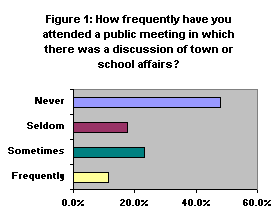 |
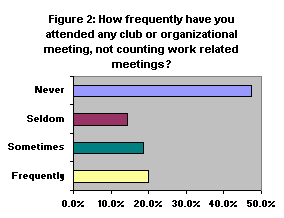 |
Table 1 presents the distributions for the two questions of civic engagement (attending a public or organizational meeting) by demographic groupings. Interestingly, the only factors that were statistically significant for attendance of a public meeting, for example, were educational attainment and sex. Education was moderately associated with ‘PUBLIC MEETING’ with respondents who had less than a high school or a high school education least likely to attend public meetings. Females were also less likely to attend public meetings than males (29.4% vs. 37.5%), however the relationship was weak.
Table 1: Civic Engagement by Demographic Determinants
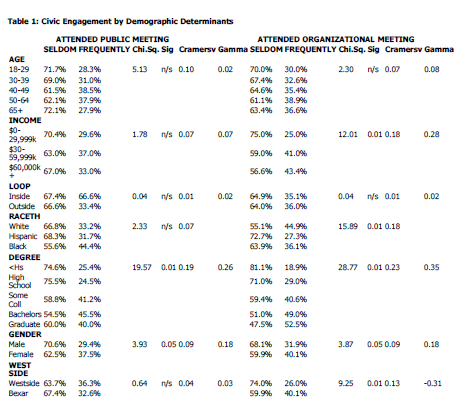 Click on graphic to view PDF version of table. |
On the other hand, participation in the form of “attendance” at an organizational meeting was significantly and moderately associated (p < .01) with income levels, educational attainment, race/ethnicity and living on the West side. Only a quarter of the respondents, for example, with incomes under $30,000 said they attended organizational meetings “frequently” compared to the more than four in ten respondents with incomes greater than $30,000. Fewer than one in five (18.9%) of respondents with less than a high school education attended organizational meetings compared to nearly half of the respondents with bachelors (49%) or graduate degrees (52.5%). Nearly forty five percent (44.9%) of Anglos reported that they attended organizational meetings, while fewer than twenty eight percent (27.3%) of Hispanics and just over thirty six percent (36.1%) of African Americans reported they attend organizational meetings. Respondents living on the West Side were less likely to attend organizational meetings compared to others in Bexar County (26% vs. 40.1%). Finally, females were nearly ten percent more likely to attend organizational meetings (40.1% vs. 31.9%) than males, but the relationship was weak. Age and living inside or outside loop 410 made no difference as to whether a person attended an organizational meeting.
Figures 3 and 4 display the two dimensions of meetings by race/ethnicity, controlling for geographic location. Figure 3 shows that Westsiders are slightly less likely to attend public meetings compared to others in Bexar County, but the differences are not statistically significant. Westsiders are also less likely to attend organizational meetings compared to others in Bexar County; Hispanics in the West Side, in particular, are least likely to attend organizational meetings relative to others. Anglos living on the West Side are also less likely to attend organizational meetings compared to their Anglo counterparts in the county (36.6% vs. 45.4%; see Figure 4).
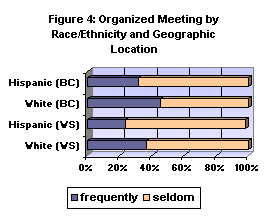 |
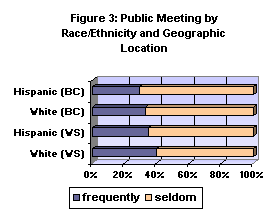 |
Discussion:
Civic engagement represents opportunity costs. One’s participation in community and organizational meetings comes at a cost of spending time with family, work responsibilities, maintaining a household and pursuing recreational activities. In addition, nonelectoral civic participation entails a sense of interest (a stake in the outcome) and efficacy (that’s one participation is important and makes a difference). As a result, typically individuals with higher socioeconomic statuses (higher educational attainment, higher income levels) are more likely to be engaged in civic participation. In addition, diverse communities have consistently been associated with lower levels of social capital. Prior research has found that civic engagement is stronger in areas that are more homogenous across class and ethnicity (Knack and Keefer 1997). [iv]
The findings of this issue brief confirm these patterns in part. In San Antonio, for example, Westsiders, residents inside the loop, the poor, racial and ethnic minorities, and the less educated are least likely to attend organizational meetings. However, many of the same factors that were significant predictors of who attended organizational meetings (e.g. income, race/ethnicity, age and geographic location) were not significant factors in determining who participated in public meetings (here only educational attainment levels and sex were significant).
The difference in civic engagement between public meetings and organizational meetings may be the nature of the meetings. Engagement in organizational meetings, for example, may be less formal and more of particular interest and efficacy, while public meetings may be more daunting (formal) and of less interest and efficacy. As such, individuals with time, money or other resources can afford opportunity costs associated with civic engagement in such meetings.
Notes
[i] The SAS 2003 is an annual survey conducted by UTSA students in research methods courses in sociology, criminal justice, kinesiology and public administration, in conjunction with The Culture and Policy Institute. The survey provides students with experience in survey research and an opportunity to measure the attitudes and perceptions of San Antonians on topics of the day. Juanita Firestone, Professor, Department of Sociology, is the principal investigator; Richard Harris, Professor, Department of Sociology, and Arturo Vega, Associate Professor, Department of Public Administration, are co-principal investigators.
[ii] The standard error for the entire sample, including the additional sample from the Westside, is +/- 4.1% with a confidence level of 95%. The SAS 2003 incorporated several questions from the Saguaro Seminar’s “Social Capital Community Benchmark Survey Short Form 2001.” The authors acknowledge the Seminar for its generosity in sharing the short form on line. www.ksg.harvard.edu/saguaro/pdfs/socialcapitalshortform.pdf
[iii] Public Meeting and Organized Meeting were coded 1 'never' 2 'seldom' 3 'some' 4 'freq' and was recoded for our analysis into 3, 4=1 ‘frequently’ and 1,2=0 ‘seldom’.
[iv] Knack, Stephen and Philip Keefer. 1997. “Does Social Capital Have an Economic Payoff? A Cross-Country Investigation.” The Quarterly Journal of Economics, Vol. 112, pp.1251-1288.